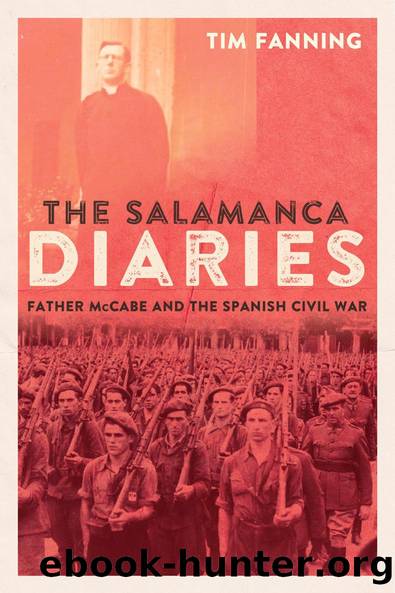The Salamanca Diaries by Tim Fanning

Author:Tim Fanning [Fanning, Tim]
Language: eng
Format: epub
Tags: History, Europe, Ireland, Spain & Portugal, Great Britain, General, Biography & Autobiography, Historical
ISBN: 9781785372797
Google: Q4urDwAAQBAJ
Publisher: Merrion Press
Published: 2019-08-23T03:26:00+00:00
* âThe glorious cripple.â
â âThe bridegrooms of death.â
â¡ âLong live death!â
* This was the Francoist motto. It roughly translates as âSpain!: United! Great! Free!â
* âDeath to the intellectuals!â
* The popular abbreviation in Salamanca for the Gran Hotel.
â Queipoâs nickname for Franco was âPaquitoâ, which roughly translates as âlittle Frankieâ.
Chapter 8
THE IRISH BRIGADE
At the beginning of August 1936, a few weeks after the military uprising in Spain, and as stories about the slaughter of priests and nuns filled the pages of the Irish newspapers, Count RamÃrez de Arellano, the Carlist who had contacted Cardinal MacRory about sending an Irish unit to Spain, wrote to Eoin OâDuffy asking him to lead a group of Irishmen into battle on the side of the nationalist armies. âWhat a glorious example Ireland could give the whole of Christendom,â wrote the Navarrese noble.1 A few weeks later, OâDuffy began appealing for volunteers in the press.
OâDuffy viewed the Spanish enterprise as an opportunity to enhance his prestige after the personal disappointments of recent years. He had enjoyed a stellar early career, having successfully led the Monaghan Brigade of the IRA during the war of independence before succeeding Richard Mulcahy as chief-of-staff. He had supported the Treaty and successfully prosecuted the campaign against the anti-Treatyites in Munster during the Irish Civil War. In 1922, he had become commissioner of the Garda SÃochána. His abilities as an organiser and administrator had served him well in that capacity for the ten years that Cumann na nGaedheal were in government. However, when it had looked as if his sworn enemies in Fianna Fáil were about to win office in the early 1930s, OâDuffy had been unable to set aside civil war enmities and had contemplated a coup dâétat rather than allow the government hand over power. When Ãamon de Valera won the election in 1932, OâDuffyâs days were numbered. In February 1933, de Valera argued that OâDuffy would be unable to set aside his political prejudices and dismissed him as garda commissioner. OâDuffy refused to accept another role of equivalent responsibility in the public service. Yet within the space of five months of his public humiliation at the hands of de Valera, OâDuffy was the leader of a mass movement in direct confrontation with the government.
The National Guard â or Blueshirts as they became known because of the colour of their uniforms â evolved out of the Army Comrades Association. This latter body had been set up to look after the interests of ex-National Army members, but it soon became a political movement whose declared aim was to defend the country from left-wing and republican elements. The Blueshirts acted as bodyguards to Cumann na nGaedheal speakers at public meetings around the country and were frequently involved in violent clashes with the IRA. The National Guard adopted the accoutrements of European fascism, such as the shirted uniform and Roman salute, as well as much of its ideology. It was fiercely anti-communist and declared itself committed to the corporate and vocational ideas then in vogue.
Download
This site does not store any files on its server. We only index and link to content provided by other sites. Please contact the content providers to delete copyright contents if any and email us, we'll remove relevant links or contents immediately.
| France | Germany |
| Great Britain | Greece |
| Italy | Rome |
| Russia | Spain & Portugal |
Fanny Burney by Claire Harman(25792)
Empire of the Sikhs by Patwant Singh(22185)
Out of India by Michael Foss(16315)
Leonardo da Vinci by Walter Isaacson(11918)
Small Great Things by Jodi Picoult(6108)
The Six Wives Of Henry VIII (WOMEN IN HISTORY) by Fraser Antonia(4799)
The Wind in My Hair by Masih Alinejad(4427)
The Lonely City by Olivia Laing(4126)
The Crown by Robert Lacey(4115)
A Higher Loyalty: Truth, Lies, and Leadership by James Comey(4039)
The Iron Duke by The Iron Duke(3650)
Millionaire: The Philanderer, Gambler, and Duelist Who Invented Modern Finance by Janet Gleeson(3576)
Sticky Fingers by Joe Hagan(3456)
Alive: The Story of the Andes Survivors by Piers Paul Read(3320)
Papillon (English) by Henri Charrière(3280)
Joan of Arc by Mary Gordon(3270)
Stalin by Stephen Kotkin(3091)
Aleister Crowley: The Biography by Tobias Churton(3026)
Ants Among Elephants by Sujatha Gidla(2928)
